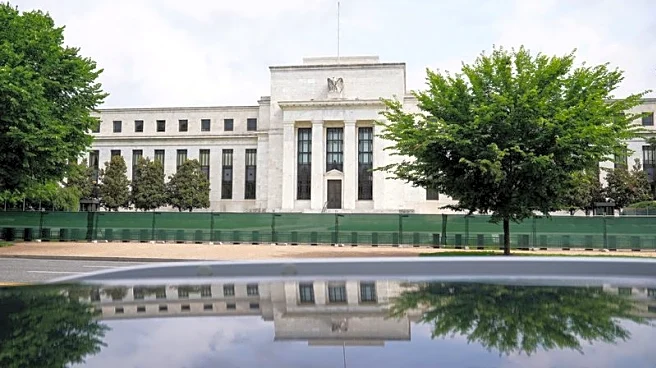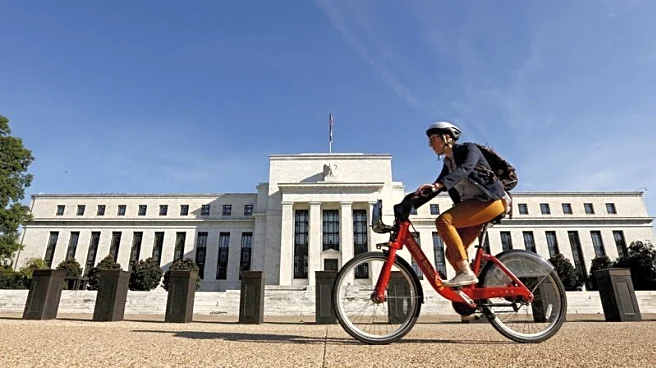By Gertrude Chavez-Dreyfuss and Laura Matthews
NEW YORK (Reuters) -Bond investors are buying longer-term maturities up to 10-year debt and ramping up bets on a steeper yield curve, anticipating that the Federal Reserve will cut interest rates this week after a nine-month pause.
The U.S. central bank's policy-setting Federal Open Market Committee is widely expected to reduce its benchmark overnight interest rate by 25 basis points (bps) to the 4.00%-4.25% range at the conclusion of a two-day meeting
on Wednesday, reconciling a weakening labor market with moderate inflation.
Ahead of the rate decision, fixed income investors are adding duration to portfolios, a move that seeks to take advantage of lower interest rates. Duration, measured in years to maturity, indicates how much a bond's price is likely to rise or fall when rates change.
In general, when rates fall, higher-duration bonds experience a greater increase in value compared to those with lower duration. Long-duration bets typically involve buying longer-dated assets.
From the long end, to short maturities and derivatives, the market has gained confidence that the Fed is ready to reduce borrowing costs after the latest data showed that the U.S. unemployment rate rose to 4.3% in August and job growth was much lower than forecast.
That data and other recent figures indicated that the labor market is in worse shape than the Fed had banked on since it paused its rate cuts in January.
On the other side of the Fed's dual mandate to control inflation and maximize employment, the Consumer Price Index for August came in higher than expected last week, although producer prices were more benign than expected.
"The general trend in the market is a little bit more of a bond-buying view, so pro-bonds in this scenario where rates are likely to go down," said Kathryn Kaminski, chief research strategist and a portfolio manager at AlphaSimplex Group.
"They are trying to get ahead of the Fed to be prepared for potential rate cuts. The next leg of that is: what are the longer-term implications of that? How many cuts and is inflation still something we need to think about?"
IT'S ALL ABOUT DURATION
Vishal Khanduja, head of the broad markets fixed income team at Morgan Stanley Investment Management in Boston, said he has added more duration to his portfolio in the last six weeks in the five- to 10-year sectors.
"If the Fed shifts from restrictive to dovish, and (policy) rates, for example, go down from 4.25% to 3.25% in the next three meetings, then you could clearly say that your overall interest rate curve should also be going lower," Khanduja noted.
"That means the higher the duration you have in the fixed income portfolio, you should be mathematically making positive returns because your duration is directly sensitive to the yield."
J.P. Morgan, in its latest Treasury survey as of September 8, said the percentage of all clients that are long duration increased to 30% from 28% in the previous week, posting the most outright longs since early August.
In the short-term fixed income space, money market funds have also been extending duration in anticipation of a rate cut. Government money market funds have lengthened their weighted average maturities (WAMs) by 3.4 days to an average of 40 days, while prime funds have extended them by 2.2 days to 29 days, over the past month, Teresa Ho, managing director and head of short-duration strategy at J.P. Morgan, wrote in a recent research note.
She added that both government and prime fund WAMs, as of early September, stood at their highest levels this year, and at their longest since June 2021.
Meanwhile, as of September 10, CME Group data showed options on the Secured Overnight Financing Rate (SOFR) futures saw large volumes for the September three-month expiry call options, with a strike of 96. That trade implies that the average three-month SOFR during the September-December period will be lower than 4%.
SOFR, which tracks the benchmark fed funds futures, reflects the cost of borrowing cash overnight, with Treasuries as collateral. Open interest on SOFR futures hit an all-time record of 15.1 million contracts that day.
STEEPENING TRADES CONTINUE TO SURGE AHEAD
Bond investors also have continued to pile on steepeners, a popular trade this year, especially in the Treasury five-year/30-year yield curve. They are buying the shorter end of that curve with the expectation of Fed rate cuts, but selling the 30-year bond, pushing the latter's yields higher amid persistent worries about high U.S. fiscal deficit.
The U.S. 5-year/30-year yield curve steepened to 126 bps on September 5, its widest in more than four years, but narrowed to 104.8 bps on Monday. Investors said there is now an opportunity to reload on that trade.
Jeffrey Klingelhofer, managing director and portfolio manager at Aristotle Pacific Capital in Newport Beach, California, said that a steeper curve could be obtained in a situation where inflation stays stubbornly high if tariffs spur the Fed to pause its easing cycle.
"In that case, you don't really need rates to come down. You can just have the long end go up because of the inflation concern."
The Fed on Wednesday also is due to release updated quarterly economic projections including rate forecasts, which are plotted on the widely watched "dot plot." The dots from the meeting in June showed the median expectation from policymakers was for 50 bps of cuts this year and single 25-bp declines in 2026 and 2027.
Analysts said there is a risk this year's median projection will show two further rate reductions.
(Reporting by Gertrude Chavez-Dreyfuss; Editing by Alden Bentley and Paul Simao)












